Prospects of Using Hydrocarbon Deposits from the Autochthonous Miocene Formation (Eastern Carpathian Foredeep, Poland) for Geothermal Purposes
Abstract
1. Introduction
2. Materials and Methods
3. General Characteristics of the Analyzed Area
3.1. Location
3.2. Geological Background
4. Geothermal Characteristics of the Analyzed Area
4.1. Miocene Thickness
4.2. Thermic Parameters
4.3. Temperatures
4.4. Water-Bearing Horizons
4.5. Boreholes’ Capacities
4.6. Total Dissolved Solids
4.7. Reservoir Parameters
5. Petroleum Characteristic of the Analyzed Area
5.1. Miocene Reservoir Rocks
5.2. Hydrocarbon Traps and Gas Migration
6. Primarily Thermal Characteristic of Selected Hydrocarbon Reservoirs
6.1. Estimated Temperatures in Selected Deposits
x = 2663.5
6.2. Characteristics of a Few Natural Gas Fields
6.2.1. Pilzno Południe Field (No. 42)
6.2.2. Kielanówka-Rzeszów Field (No. 26)
6.2.3. Zalesie Field (No. 65)
6.2.4. Jodłówka Field (No. 23)
6.2.5. Przemyśl Field (No. 46)
7. Potential Hazards Connected to the Geothermal Energy Utilization in the Studied Area
8. Discussion
9. Conclusions
Author Contributions
Funding
Institutional Review Board Statement
Informed Consent Statement
Data Availability Statement
Conflicts of Interest
References
- Bundschuh, J.; Chen, G.; Tomaszewska, B.; Ghaffour, N.; Mushtaq, S.; Hamawand, I.; Reardon-Smith, K.; Maraseni, T.; Banhazi, T.; Mahmoudi, H.; et al. Solar, wind and geothermal energy application in agriculture: Back to the future? In Geothermal, Wind and Solar Energy Applications in Agriculture and Aquaculture (Sustainable Energy Developments); Bundschuh, J., Chen, G., Chandrasekharam, D., Piechocki, J., Eds.; CRC Press, Taylor & Francis Group: London, UK, 2017; pp. 1–32. [Google Scholar]
- Liu, X.; Falcone, G.; Alimonti, C. A systematic study of harnessing low-temperature geothermal energy from oil and gas reservoirs. Energy 2018, 142, 346–355. [Google Scholar] [CrossRef]
- Hajto, M.; Sowiżdżał, A. A global assessment of geothermal resources. In Geothermal Water Management (Sustainable Water Developments: Resources, Management, Treatment, Efficiency and Reuse); Bundschuh, J., Tomaszewska, B., Eds.; CRC Press, Taylor & Francis Group: London, UK, 2018; pp. 3–30. [Google Scholar]
- Tomaszewska, B.; Pająk, L.; Bundschuh, J.; Bujakowski, W. Low-enthalpy geothermal energy as a source of energy and integrated freshwater production in inland areas: Technological and economic feasibility. Desalination 2018, 435, 35–44. [Google Scholar] [CrossRef]
- Pająk, L.; Tomaszewska, B.; Bujakowski, W.; Bielec, B.; Dendys, M. Review of the low-enthalpy Lower Cretaceous geothermal energy resources in Poland as an environmentally friendly source of heat for urban district heating systems. Energies 2020, 13, 1302. [Google Scholar] [CrossRef]
- Ghaffour, N.; Bundschuh, J.; Mahmoudi, H.; Goosen, M.F.A. Renewable energy-driven desalination technologies: A comprehensive review on challenges and potential applications of integrated systems. Desalination 2015, 356, 94–114. [Google Scholar] [CrossRef]
- Gude, V.G. Geothermal source potential for water desalination—Current status and future perspective. Renew. Sust. Energy Rev. 2016, 57, 1038–1065. [Google Scholar] [CrossRef]
- Lund, J.W.; Boyd, T.L. Direct utilization of geothermal energy 2015 worldwide review. Geothermics 2015, 60, 66–93. [Google Scholar] [CrossRef]
- Bertani, R. Geothermal power generation in the world 2010–2014 update report. Geothermics 2016, 60, 31–43. [Google Scholar] [CrossRef]
- Świerszcz, K.; Osial, M. Energy poverty and geothermal resources in the county’s energy security strategy. In Contemporary Management and Security Problems; Runiewicz, R., Żylińska, J., Szczerbak, M., Przychocka, I., Gawkowski, K., Eds.; University of Technology and Economics in Warsaw: Warsaw, Poland, 2019; pp. 260–285. [Google Scholar]
- Kaczmarczyk, M.; Sowiżdżał, A.; Tomaszewska, B. Energetic and Environmental Aspects of Individual Heat Generation for Sustainable Development at a Local Scale—A Case Study from Poland. Energies 2020, 13, 454. [Google Scholar] [CrossRef]
- Mackiewicz, M. Energia geotermalna, a bezpieczeństwo energetyczne Polski-ujęcie prawne. In Bezpieczeństwo energetyczne, rynki surowców i energii-teraźniejszość i przyszłość; Kwiatkiewicz, P., Ed.; FNCE: Poznań, Poland, 2014; pp. 289–305. [Google Scholar]
- Bujakowski, W.; Bielec, B.; Miecznik, M.; Pająk, L. Reconstruction of geothermal boreholes in Poland. Geotherm. Energy 2020, 8, 10. [Google Scholar] [CrossRef]
- Sowiżdżał, A.; Tomaszewska, B.; Chmielowska, A. Development of the Polish geothermal sector in the light of current possibilities of financial support for a geothermal investment. E3S Web Conf. 2019, 86, 00034. [Google Scholar] [CrossRef]
- Caulk, R.A.; Tomac, I. Reuse of abandoned oil and gas wells for geothermal energy production. Renew. Energy 2017, 112, 388–397. [Google Scholar] [CrossRef]
- Nian, Y.L.; Cheng, W.L. Insight into geothermal utilization of abandoned oil and gas wells. Renew. Sust. Energy Rev. 2018, 87, 44–60. [Google Scholar] [CrossRef]
- Bundschuh, J.; Ghaffour, N.; Mahmoudi, H.; Goosen, M.; Mushtaq, S.; Hoinkis, J. Low-cost low-enthalpy geothermal heat for freshwater production: Innovative applications using thermal desalination processes. Renew. Sust. Energy Rev. 2015, 43, 196–206. [Google Scholar] [CrossRef]
- Tomaszewska, B.; Bundschuh, J.; Pająk, L.; Dendys, M.; Quezada, V.D.; Bodzek, M.; Armienta, M.A.; Muñoz, M.O.; Kasztelewicz, A. Use of low-enthalpy and waste geothermal energy sources to solve arsenic problems in freshwater production in selected regions of Latin America using a process membrane distillation—Research into model solutions. Sci. Total Environ. 2020, 714, 136853. [Google Scholar] [CrossRef]
- Bu, X.; Ma, W.; Li, H. Geothermal energy production utilizing abandoned oil and gas wells. Renew. Energy 2012, 41, 80–85. [Google Scholar] [CrossRef]
- Thiessen, R.J.; Achari, G. Abandoned oil and gas well site environmental risk estimation. Toxicol. Environ. Chem. 2016, 99, 1170–1192. [Google Scholar] [CrossRef]
- Cheng, W.L.; Li, T.T.; Nian, Y.L.; Wang, C.L. Studies on geothermal power generation using abandoned oil wells. Energy 2013, 59, 248–254. [Google Scholar] [CrossRef]
- Templeton, J.D.; Ghoreishi-Madiseh, S.A.; Hassani, F.; Al-Khawaja, M.J. Abandoned petroleum wells as sustainable source of geothermal energy. Energy 2014, 70, 366–373. [Google Scholar] [CrossRef]
- Davis, A.P.; Michaelides, E.E. Geothermal power production from abandoned oil wells. Energy 2009, 34, 866–872. [Google Scholar] [CrossRef]
- Noorollahi, Y.; Pourarshad, M.; Jalilinasrabady, S.; Yousefi, H. Numerical simulation of power production from abandoned oil wells in Ahwaz oil field in southern Iran. Geothermics 2015, 55, 16–23. [Google Scholar] [CrossRef]
- Wight, N.M.; Bennett, N.S. Geothermal energy from abandoned oil and gas wells using water in combination with a close wellbore. Appl. Therm. Eng. 2015, 89, 908–915. [Google Scholar] [CrossRef]
- Nian, Y.L.; Cheng, W.L. Evaluation of geothermal heating from abandoned oil wells. Energy 2018, 142, 592–607. [Google Scholar] [CrossRef]
- Noorollahi, Y.; Taghipoor, S.; Sajadi, B. Geothermal sea water desalination system (GSWDS) using abandoned oil/gas wells. Geothermics 2017, 67, 66–75. [Google Scholar] [CrossRef]
- Tyszer, M.; Chmielowska, A.; Tomaszewska, B. Initial recognition of the possibilities of use abandoned oil and gas wells to desalinate produced water. E3S Web Conf. 2020, 154, 05002. [Google Scholar] [CrossRef]
- Templeton, J.D.; Hassani, F.; Ghoreishi-Madiseh, S.A. Study on effective solar energy storage using a double pipe geothermal. Renew. Energy 2016, 86, 173–181. [Google Scholar] [CrossRef]
- Bujakowski, W. Rekonstrukcja otworu Mszczonów IG-1 na potrzeby eksploatacji złoża geotermalnego do systemu grzewczego. In Wybrane problemy wykorzystania geotermii—I. Studia Rozprawy Monografie nr 76; Bujakowski, W., Ed.; MEERI PAS: Kraków, Poland, 2000; pp. 63–107. [Google Scholar]
- Bujakowski, W. Reconstruction of the MszczonówIG-1 well against the background of other selected geothermal wells’ reconstruction projects. Geol. Explor. Technol. Geotherm. Energy Sustain. Dev. 2015, 1, 17–34. [Google Scholar]
- Bielec, B.; Balcer, M. The long–term monitoring of the thermal water reservoir exploitation, technical condition of the Mszczonów IG-1 wellborne and production zone. Geol. Explor. Technol. Geotherm. Energy Sustain. Dev. 2015, 1, 37–57. [Google Scholar]
- Cheng, W.L.; Liu, J.; Nian, Y.L.; Wang, C.L. Enhancing geothermal power generation from abandoned oil wells with thermal reservoir. Energy 2016, 109, 537–545. [Google Scholar] [CrossRef]
- Sapińska-Śliwa, A.; Rosen, M.A.; Gonet, A.; Śliwa, T. Deep Borehole Heat Exchangers—A Conceptual Review. In Proceedings of the World Geothermal Congress 2015, Melbourne, Australia, 19–25 April 2015. [Google Scholar]
- Chmielowska, A.; Tomaszewska, B.; Sowiżdżał, A. The Utilization of Abandoned Petroleum Wells in Geothermal Energy Sector. Worldwide Trends and Experience. E3S Web Conf. 2020, 154, 05004. [Google Scholar] [CrossRef]
- Cheng, W.L.; Li, T.T.; Nian, Y.L.; Xie, K. Evaluation of working fluids for geothermal power generation from abandoned oil wells. Appl. Energy 2014, 118, 238–245. [Google Scholar] [CrossRef]
- Polish Geological Institute-National Research Institute. Oil and Gas in Poland—New Opportunities. Available online: https://infolupki.pgi.gov.pl/sites/default/files/czytelnia_pliki/folder_na_bruksele.pdf (accessed on 20 May 2020).
- Górecki, W.; Sowiżdżał, A.; Hajto, M.; Wachowicz-Pyzik, A. Atlases of geothermal waters and energy resources in Poland. Environ. Earth Sci. 2015, 74, 7487–7495. [Google Scholar] [CrossRef]
- Wójcicki, W.; Sowiżdżał, A.; Bujakowski, W. Ocena potencjału, bilansu cieplnego i perspektywicznych struktur geologicznych dla potrzeb zamkniętych systemów geotermicznych (Hot Dry Rocks) w Polsce; Ministry of the Environment: Warszawa/Kraków, Poland, 2013. [Google Scholar]
- Bujakowski, W.; Tomaszewska, B. Atlas of the Possible Use of Geothermal Waters for Combined Production of Electricity and Heat Using Binary Systems in Poland; MEERI PAS: Kraków, Poland, 2014. [Google Scholar]
- Miecznik, M.; Sowiżdżał, A.; Tomaszewska, B.; Pająk, L. Modeling geothermal conditions in part of the Szczecin Trough—The Chociwel area. GEOLOGOS 2015, 21, 187–196. [Google Scholar] [CrossRef]
- Wachowicz-Pyzik, A.; Sowiżdżał, A.; Pająk, L.; Ziółkowski, P.; Badur, J. Assessment of the effective variants leading to higher efficiency for the geothermal doublet, using numerical analysis-case study from Poland (Szczecin Trough). Energies 2020, 13, 2174. [Google Scholar] [CrossRef]
- Sowiżdżał, A.; Chmielowska, A.; Tomaszewska, B.; Operacz, A.; Chowaniec, J. Could geothermal water and energy use improve living conditions? Environmental effects from Poland. Arch. Environ. Prot. 2019, 45, 109–118. [Google Scholar] [CrossRef]
- Maćkowski, T.; Sowiżdżał, A.; Wachowicz-Pyzik, A. Seismic methods in geothermal water resource exploration: Case study from Łódź Trough, central part of Poland. Geofluids 2019, 3052806, 1–11. [Google Scholar] [CrossRef]
- Kępińska, B. A review of geothermal energy uses in Poland in 2016−2018. Geol. Explor. Technol. Geotherm. Energy Sustain. Dev. 2018, 1, 11–28. [Google Scholar]
- Sowiżdżał, A. Geothermal energy resources in Poland—Overview of the current state of knowledge. Renew. Sust. Energy Rev. 2018, 82, 4020–4027. [Google Scholar] [CrossRef]
- Kondracki, J. Geografia Regionalna Polski; PWN: Warszawa, Poland, 2009. [Google Scholar]
- Sowiżdżał, K.; Słoczyński, T.; Sowiżdżał, A.; Papiernik, B.; Machowski, G. Miocene biogas generation system in the Carpathian Foredeep (SE Poland): A basin modeling study to assess the potential of unconventional mudstone reservoirs. Energies 2020, 13, 1838. [Google Scholar] [CrossRef]
- Oszczypko, N. Development of the Polish sector of the Carpathian Foredeep. Pol. Geol. Rev. 2006, 54, 396–403. [Google Scholar]
- Górecki, W. Geothermal Atlas of the Carpathian Foredeep; KSE AGH-UST: Kraków, Poland, 2012. [Google Scholar]
- Karnkowski, P. Złoża gazu ziemnego i ropy naftowej w Polsce. Tom 2. Karpaty i zapadlisko przedkarapackie; WNT: Kraków, Poland, 1993. [Google Scholar]
- Sowiżdżał, A. Characterization of geothermal reservoirs parameters in Polish part of Carpathian Foredeep. Carpath J. Earth Environ. 2015, 10, 237–246. [Google Scholar]
- Sowiżdżał, A.; Górecki, W. Possibilities of geothermal energy utilization in the Carpathian Foredeep. Geol. Explor. Technol. Geotherm. Energy Sustain. Dev. 2013, 52, 59–73. [Google Scholar]
- Sowiżdżał, A.; Jasnos, J. The analysis of chemical composition of groundwaters from Miocene formations in the Carpathians Foredeep from the point of view therapeutical properties. Geol. Explor. Technol. Geotherm. Energy Sustain. Dev. 2011, 1–2, 365–376. [Google Scholar]
- Chowaniec, J. Wody podziemne wschodniej części Karpat i zapadliska przedkarpackiego oraz ich ochrona. In Poszukiwanie węglowodorów jako źródło postępu w rozpoznawaniu budowy geologicznej Karpat, Zapadliska Przedkarpackiego i ich podłoża; Dziadzio, P., Uchman, A., Eds.; Polish Geological Institute: Iwonicz-Zdrój, Poland, 2004; pp. 79–91. [Google Scholar]
- Piesik-Buś, W.; Miziołek, M. Bilans stanu zasobów gazu ziemnego na przykładzie złóż zapadliska przedkarpackiego. Naft. Gaz 2016, 11, 945–952. [Google Scholar] [CrossRef]
- Myśliwiec, M. The Miocene reservoir rocks of the Carpathian Foredeep. Pol. Geol. Rev. 2004, 52, 581–592. [Google Scholar]
- Myśliwiec, M. Traps for gas accumulations and the resulting zonation of the gas fields in the Miocene strata of the eastern part of the Carpathian Foredeep (SE Poland). Pol. Geol. Rev. 2004, 52, 657–664. [Google Scholar]
- Szuflicki, M.; Malon, A.; Tymiński, M. Bilans zasobów złóż kopalin w Polsce wg stanu na 31/12/2018; Polish Geological Institute-National Research Institute: Warszawa, Poland, 2019. [Google Scholar]
- Central Geological Database. Download Manager. Boreholes. Mineral Resources-Mineral Raw Materials Deposits. Mineral Resources–Concessions–Prospecting and Exploration of Hydrocarbons Fields. Available online: http://dm.pgi.gov.pl/ (accessed on 20 June 2020).
- Polish Geological Institute-National Research Institute. Mineral Deposits. Available online: http://geoportal.pgi.gov.pl/midas-web/pages/index.jsf?conversationContext=3 (accessed on 28 June 2020).
- The Head Office of Geodesy and Cartography. View Services (WMS and WMTS). Available online: https://www.geoportal.gov.pl/uslugi/usluga-przegladania-wms (accessed on 20 June 2020).
- The Head Office of Geodesy and Cartography. Map of the Distribution of Crude Oil and Natural Gas Deposits in Poland. Available online: http://geoportal.pgi.gov.pl/css/surowce/images/2013/mapy/large/large_7.jpg (accessed on 10 May 2020).
- Myśliwiec, M. Modelowanie i symulacja złóż ropy naftowej i gazu ziemnego. Pol. Geol. Rev. 1997, 45, 376–387. [Google Scholar]
- Borys, Z. Aktualne problemy poszukiwań węglowodorów we wschodniej części przedgórza Karpat. Pol. Geol. Rev. 1996, 44, 1019–1023. [Google Scholar]
- Uliasz-Misiak, B.; Chruszcz-Lipska, K. Hydrogeochemical aspects associated with the mixing of formation waters injected into the hydrocarbon reservoir. Miner. Resour. Manag. 2017, 33, 69–80. [Google Scholar] [CrossRef]
- Ney, R.; Burzewski, W.; Bachleda, T.; Górecki, W.; Jakóbczak, K.; Słupczyński, K. Zarys paleogeografii i rozwoju litologiczno–facjalnego utworów miocenu zapadliska przedkarpackiego. Pol. Geol. Rev. 1974, 82, 1–65. [Google Scholar]
- Oszczypko, N. Przebieg mioceńskiej subsydencji w polskiej części zapadliska przedkarpackiego. Pr. Państw. Inst. Geol. 1999, 168, 209–230. [Google Scholar]
- Garecka, M.; Jugowiec, M. Wyniki badań biostratygraficznych miocenu zapadliska przedkarpackiego na podstawie nanoplanktonu wapiennego. Pr. Państw. Inst. Geol. 1999, 168, 29–40. [Google Scholar]
- Krzywiec, P. Geodynamic and tectonic control on evolution of foreland basins, with references to the Carpathian Foredeep Basin. Pol. Geol. Rev. 2006, 54, 404–412. [Google Scholar]
- Jawor, E. The structure of the deep substratum in the region east of Cracow. Acta Geol. Pol. 1970, 20, 709–762. [Google Scholar]
- Konior, K. General paleostructural analysis and characteristics of reservoir rocks of the Rzeszotary elevation and the neighbouring areas. Pol. Geol. Rev. 1978, 112, 3–63. [Google Scholar]
- Plewa, M. The heat flow on the Polish territory. Zesz. Nauk. AGH Geofiz. Stosow. 1991, 1373, 141–151. [Google Scholar]
- Gordienko, V.; Zavgorodnaya, O.V. Estimation of Heat Flow in Poland. Acta Geophys. Pol. 1966, 54, 173–180. [Google Scholar]
- Majorowicz, J.; Plewa, S. The results of surface heat flow investigations of the earth performed in Poland. Inst. Geophys. Acad. Sci. 1977, A-3, 103. [Google Scholar]
- Karwasiecka, M.; Bruszewska, B. Gęstość powierzchniowego strumienia cieplnego na obszarze Polski. CAG 1997, 060, 21/98a. [Google Scholar]
- Szewczyk, J.; Gientka, D. Terrestrial heat flow density in Poland—A new approach. Geol. Quart. 2009, 53, 125–140. [Google Scholar]
- Sokołowski, J. Applicability of geothermal energy in Podkarpackie Voivodeship. Geol. Explor. Technol. Geotherm. Energy Sustain. Dev. 2002, 41, 9–19. [Google Scholar]
- Sokołowski, J. Geological-structural characteristic and conditions of geothermal waters occurrence in Małopolskie Voivodeship. Geol. Explor. Technol. Geotherm. Energy Sustain. Dev. 2002, 41, 3–8. [Google Scholar]
- Internet System of Legal Acts. The Geological and Mining Law (Journal of Laws 2020 Item 1064 Art. 5.1 point 2). Available online: http://isap.sejm.gov.pl/isap.nsf/download.xsp/WDU20111630981/U/D20110981Lj.pdf (accessed on 7 July 2020).
- Macioszczyk, A.; Dobrzyński, D. Hydrogeochemia strefy aktywnej wymiany wód podziemnych; PWN: Warszawa, Poland, 2002; p. 448. [Google Scholar]
- Kotarba, M.J. Origin of natural gases in the autochthonous Miocene strata of the Polish Carpathian Foredeep. Ann. Soc. Geol Pol. 2011, 81, 409–424. [Google Scholar]
- Poprawa, P.; Papiernik, B.; Krzywiec, P.; Machowski, G.; Maksym, A. Exploration potential of the Polish petroleum provinces. Wiadomości Naft. i Gazow. 2018, 12, 4–12. [Google Scholar]
- Czernicki, J.; Kuk, S. Odkrycie złoża gazu ziemnego w utworach badenu dolnego w zapadlisku przedkarpackim. Nafta 1988, 3, 41–46. [Google Scholar]
- Kubica, B. Rozwój facjalny osadów chemicznych badenu w północnej części zapadliska przedkarpackiego. Pr. Państw. Inst. Geol. 1992, 133, 1–64. [Google Scholar]
- Maksym, A.; Dziadzio, P.; Liszka, B.; Staryszak, G. Środowisko sedymentacji utworów miocenu autochtonicznego w brzeżnej strefie Karpat, a interpretacja geologiczno-złożowa w obszarze Husów–Albigowa–Krasne. Naft. Gaz 1997, 9, 407–414. [Google Scholar]
- Karnkowski, P. Poszukiwanie i rozpoznawanie złóż węglowodorów w nieantyklinalnych strukturach. Nafta 1983, 7–8, 219–226. [Google Scholar]
- Kotarba, M.J. Warunki generowania i akumulacji węglowodorów oraz charakterystyka geochemiczna substancji organicznej w utworach miocenu autochtonicznego zapadliska przedkarpackiego. Pr. Państw. Inst. Geol. 1999, 168, 277–295. [Google Scholar]
- Karnkowski, P. Oil and Gas Deposits in Poland; The Geosynoptics Society (GEOS): Kraków, Poland, 1999; pp. 1–379. [Google Scholar]
- Myśliwiec, M. The presence of the normal faults and their relationships to gas accumulation, the Polish Carpathian Foredeep. In Proceedings of the 58th EAGE Conference and Technical Exhibition, Amsterdam, The Netherlands, 3–7 June 1996; Volume 2. [Google Scholar]
- Tissot, B.; Mattavelli, L.; Brosse, E. Trends in Organic Geochemistry and Petroleum in Italy. Deposition of Organic Facies. AAPG Stud. Geol. 1990, 30, 161–179. [Google Scholar]
- Lindal, B. Industrial and other applications of geothermal energy. Geothermal energy. In Earth Science, 12; Armstead, H.C.H., Ed.; UNESCO: Paris, France, 1973; p. 135. [Google Scholar]
- Jawor, E. Poszukiwanie i rozpoznawanie złóż węglowodorów w niestrukturalnych pułapkach w środkowej części zapadliska przedkarpackiego. Nafta 1983, 39, 161–166. [Google Scholar]
- Bulletin of Public Information of the Roźwienica Commune. Project’s Characteristic. Available online: http://www.rozwienica.itl.pl/bip/atach/4/1380/6261/Zal_cznik%20do%20decyzji_Charakterystyka%20%20przedsiewziecia%20WOOS.420.13.5.2018.PW.75.pdf (accessed on 17 June 2020).
- Tomaszewska, B.; Szczepański, A. Possibilities for the efficient utilisation of spent geothermal waters. Environ. Sci. Pollut. Res. 2014, 21, 11409–11417. [Google Scholar] [CrossRef] [PubMed]
- Tester, J.W. Chapter 8—Environmental Impacts, Attributes, and Feasibility Criteria. In The Future of Geothermal Energy; Massachusettes Institute of Technology: Cambridge, MA, USA, 2006; pp. 1–19. [Google Scholar]
- Nardini, I. 2013: Environmental Issues: An Overview of Possible Environmental Impacts Related to Geothermal Power Production. Available online: http://www.geoelec.eu/wp-content/uploads/2013/07/GEOELEC-Environmental-issues_Nardini.pdf (accessed on 17 May 2021).
- Allis, R.; Bromley, C.; Currie, S. Update on subsidence at the Wairakei-Tauhara geothermal system, New Zealand. Geothermics 2009, 38, 169–180. [Google Scholar] [CrossRef]
- National Bank of Poland. Exchange Rates. Available online: https://www.nbp.pl/home.aspx?f=/kursy/kursya.html (accessed on 15 June 2020).

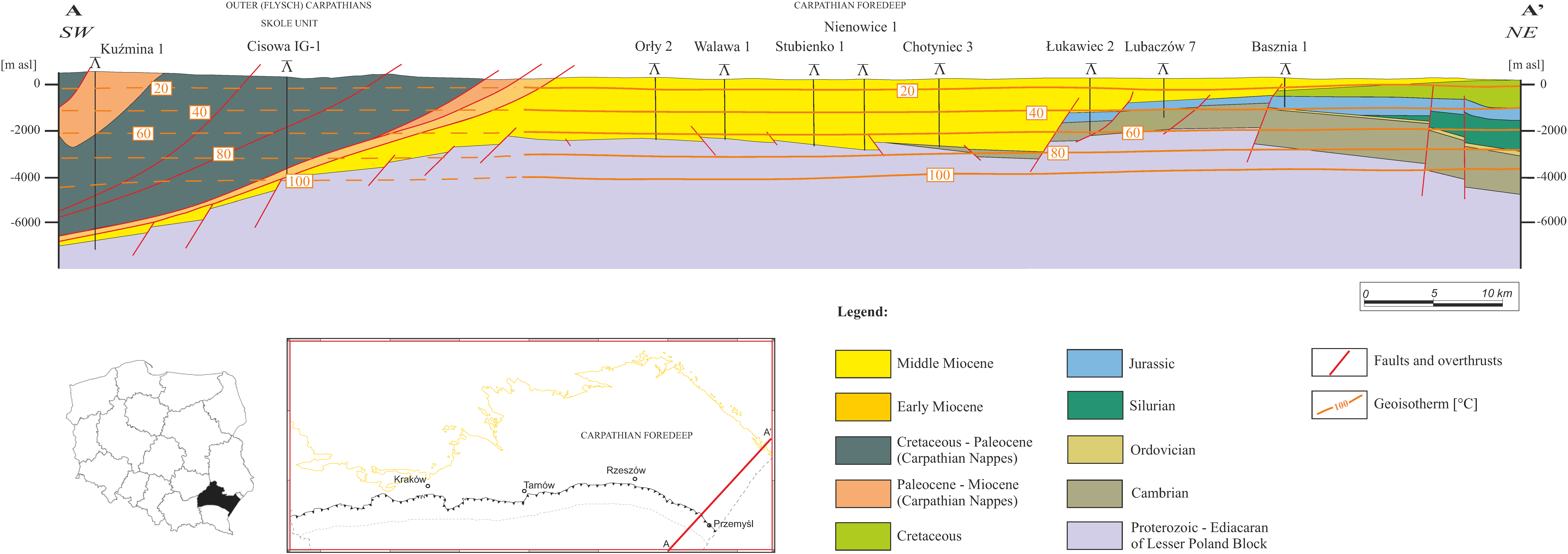
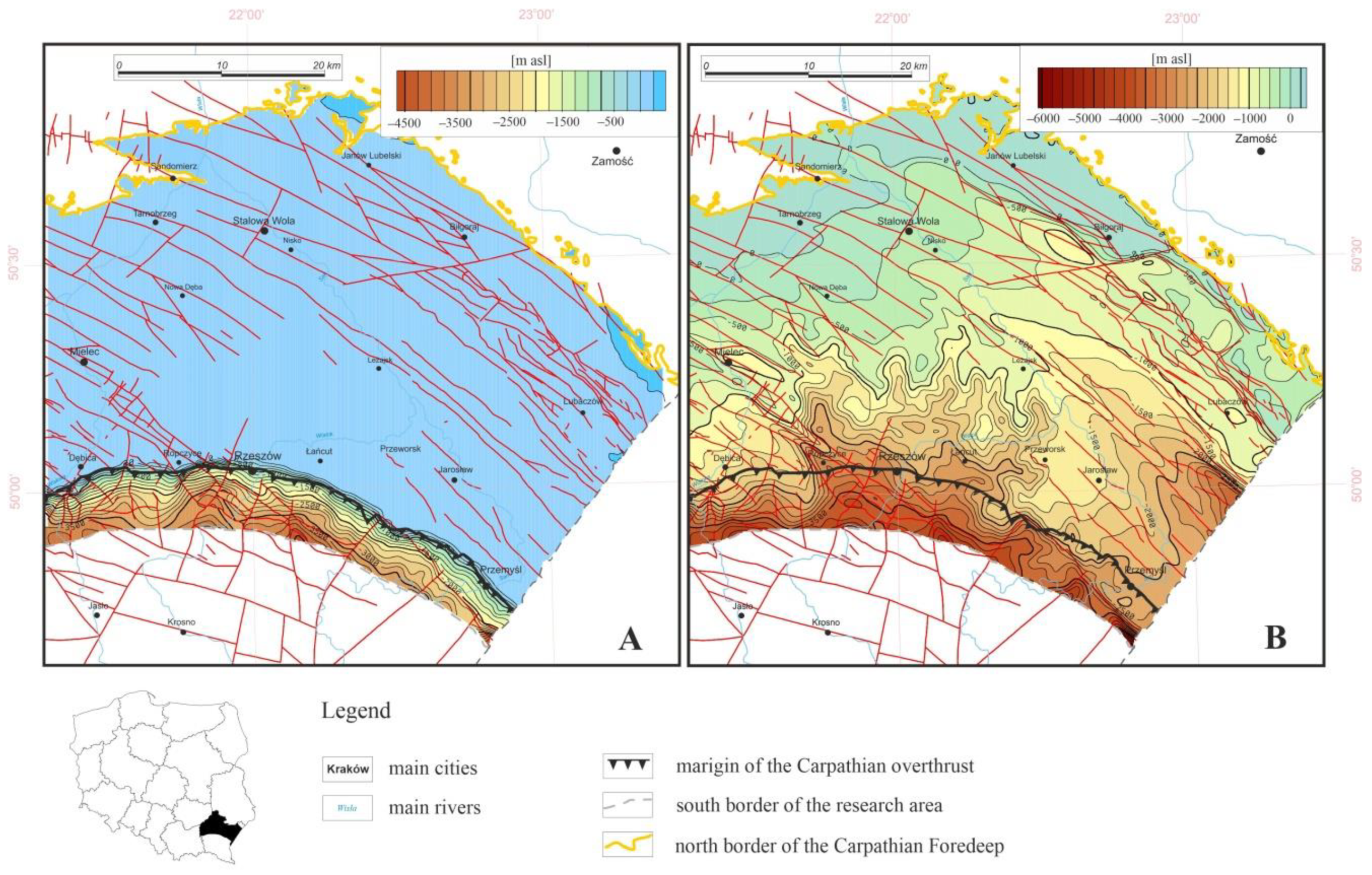

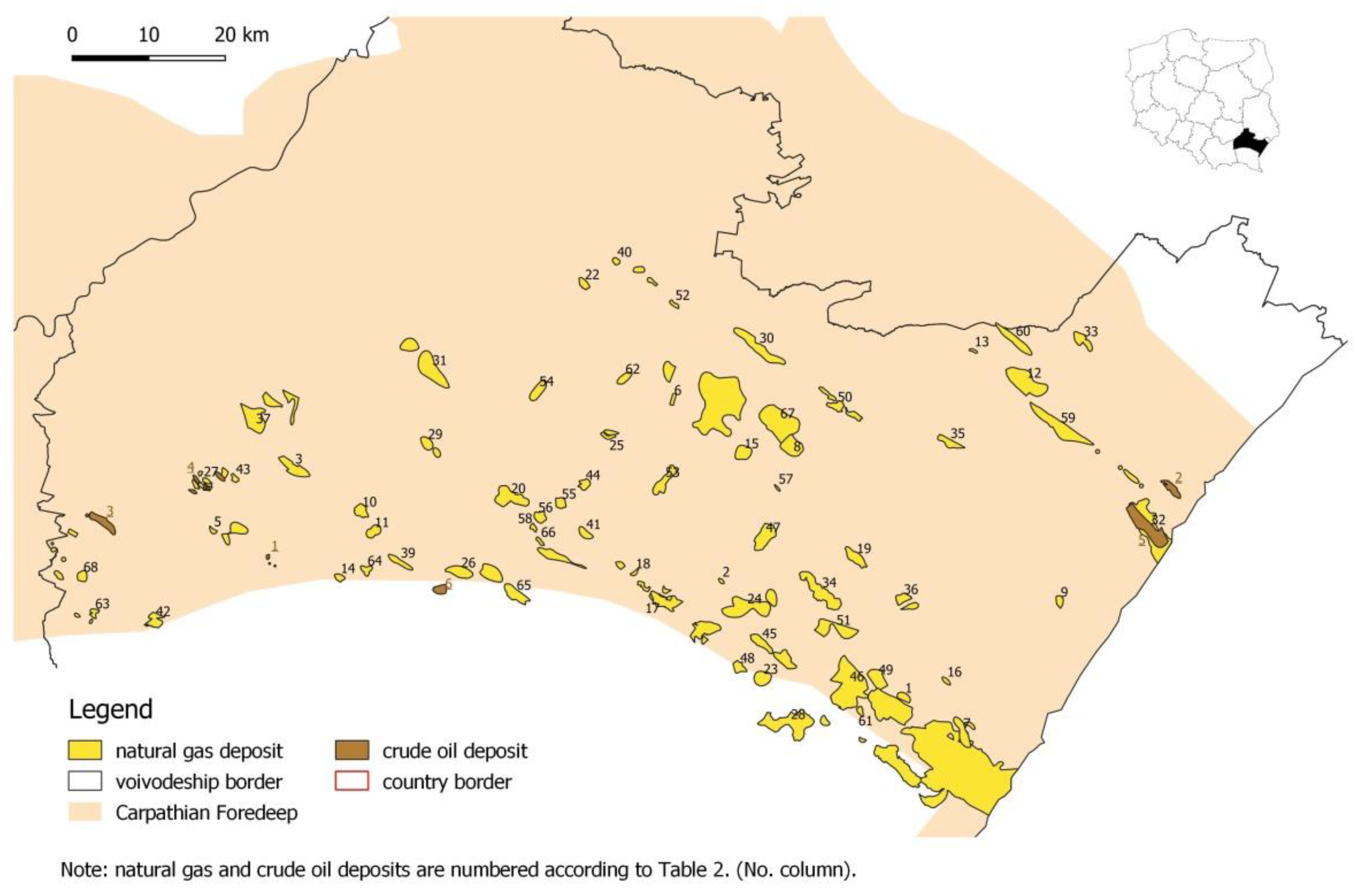
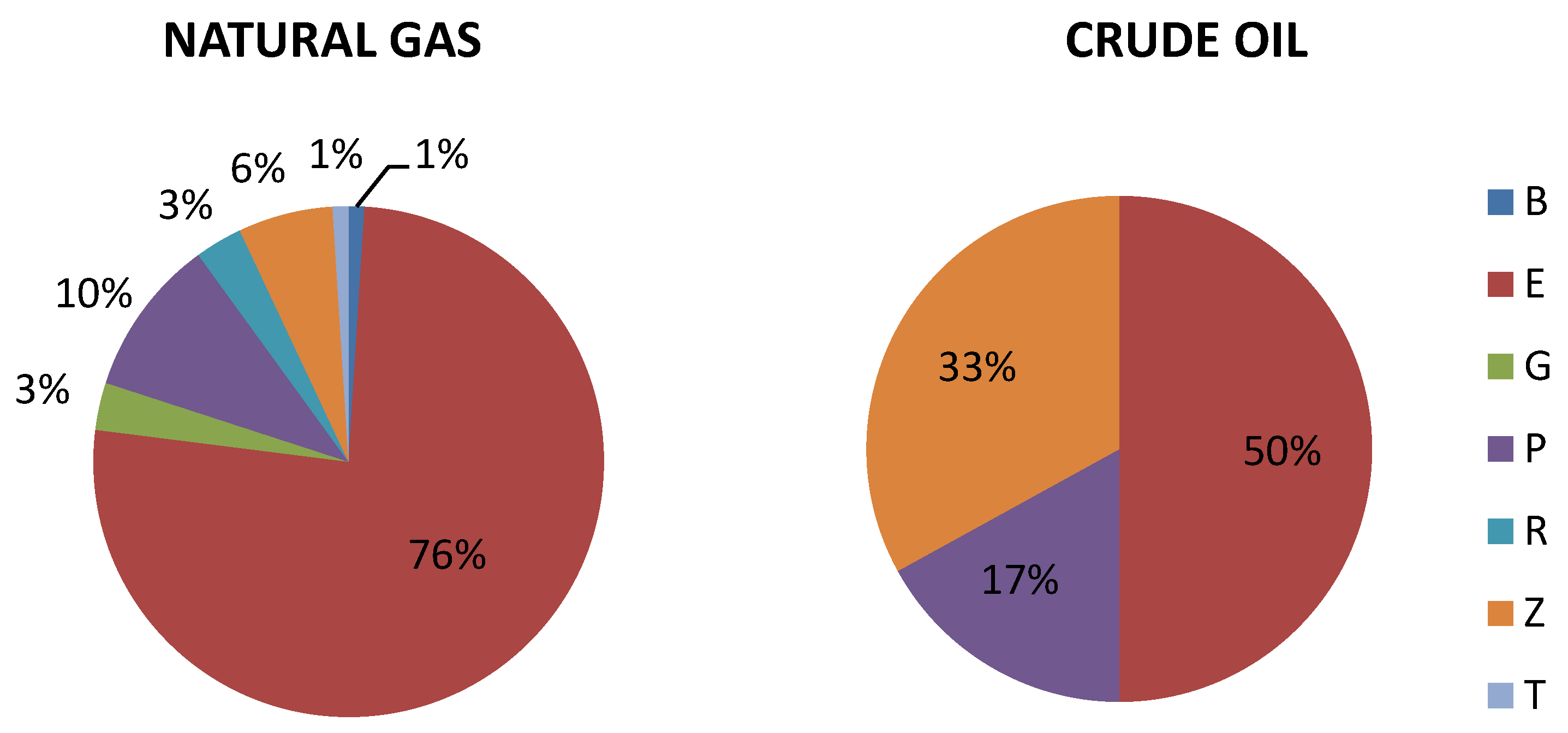
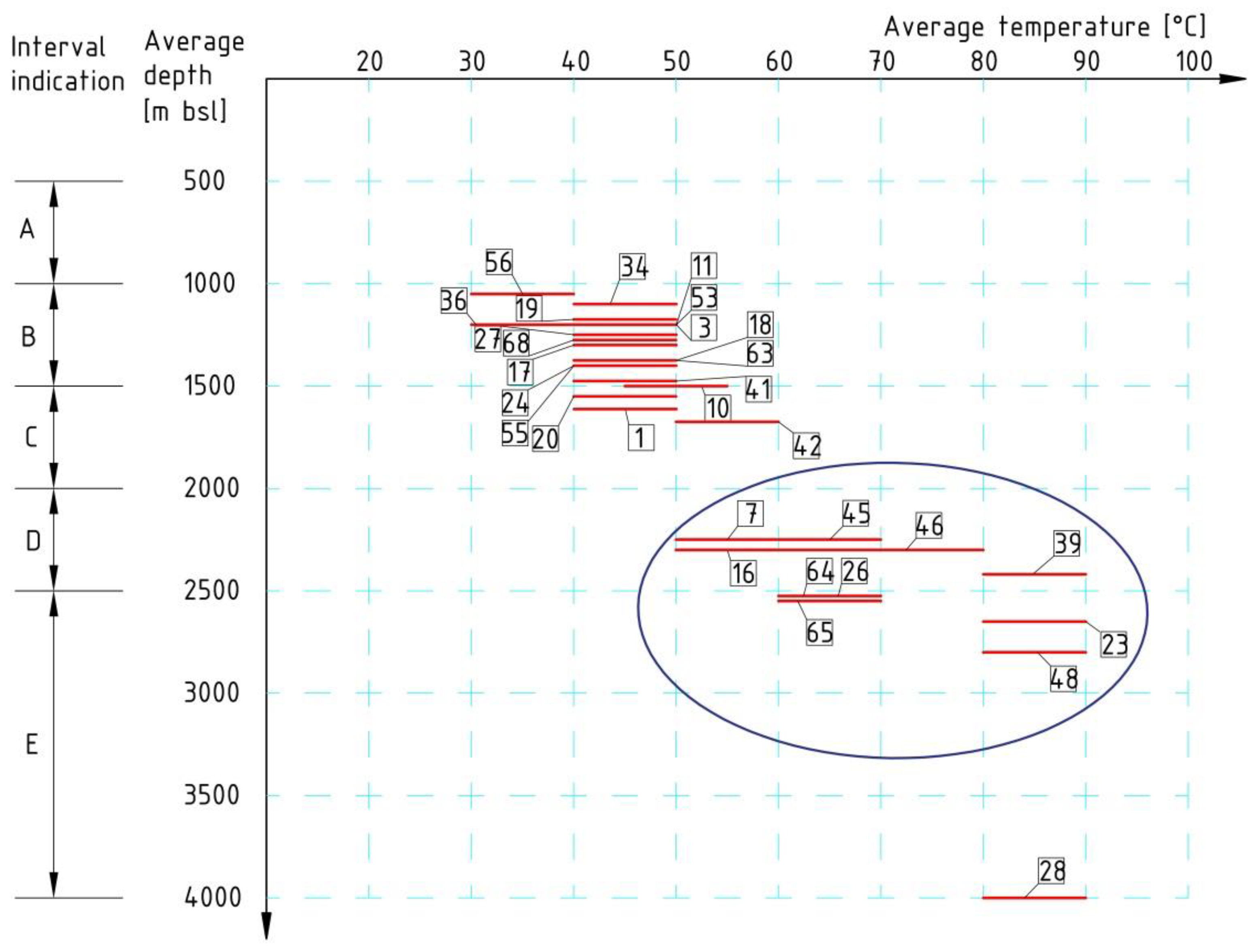
| Determined Intervals | Qmin [m3/h] | Qmax | ||
|---|---|---|---|---|
| Symbol | Depth [m bsl] | Value [m3/h] | Location | |
| A | 500–1000 | 0–10 | 130–140 | north-east direction from Leżajsk |
| B | 1000–1500 | 0–10 | 40–50 | north- and eastwards from Rzeszów |
| C | 1500–2000 | 0–10 | 30–40 | half-way from Rzeszów to Przemyśl |
| D | 2000–2500 | 0–10 | 30–40 | eastwards from Jarosław town |
| E | 2500–3500 | 0–10 | 20–30 | near Ropczyce town |
| No. | Field’s Name | Deposit Development State | Deposits [Million m3] | Production | |||
|---|---|---|---|---|---|---|---|
| Exploitable Recoverable/Off-Balance (p) | Industrial | ||||||
| Altogether | A + B cat. | C cat. | |||||
| Natural Gas | |||||||
| 1 | Batycze | E | 9.37 | - | 9.37 | 5.37 | 3.14 |
| 2 | Białoboki | E | 39.61 | - | 39.61 | 23.61 | 2.67 |
| 3 | Blizna-Ocieka | T | 119.95 | - | 119.95 | 33.19 | - |
| 4 | Brzezówka | E | 15.65 | 15.65 | - | 0.29 | 0.21 |
| 5 | Brzeźnica | G | 45.59 | 45.59 | - | 45.59 | - |
| 6 | Brzóza Królewska | R | 24.00 | - | 24.00 | - | - |
| 7 | Buszkowiczki (Przemyśl) | E | 143.14 | 24.00 | 119.14 | 28.94 | 6.75 |
| 8 | Chałupki Dębniańskie | E | 155.10 | 79.43 | 75.67 | 13.67 | 8.74 |
| 9 | Chotyniec | P | 40.00 | - | 40.00 | - | - |
| 10 | Cierpisz | E | 678.78 | - | 678.78 | 242.11 | 10.88 |
| 11 | Czarna Sędziszowska | E | 32.93 | - | 32.93 | 12.51 | 0.01 |
| 12 | Dzików | E | 848.91 | 282.37 | 566.54 | 96.47 | 66.17 |
| 13 | Dzików Stary | B | 15.27 | - | 15.27 | 15.27 | - |
| 14 | Góra Ropczycka | E | 116.66 | - | 116.66 | 79.94 | 4.00 |
| 15 | Grodzisko Dolne | E | 108.25 | - | 108.25 | 59.68 | 2.05 |
| 16 | Gubernia | E | 0.56 | 0.56 | - | - | 0.39 |
| 17 | Husów | G | 372.88 | 372.88 | - | 372.88 | - |
| 18 | Husów-Albigowa-Krasne | E | 1460.07 | 201.21 | 1258.86 | 327.37 | 21.44 |
| 19 | Jarosław | E | 810.54 | 765.07 | 45.47 | 68.23 | 6.26 |
| 20 | Jasionka | E | 992.79 | - | 992.79 | 514.6 | 31.58 |
| 21 | Jastrząbka Stara | E | 0.63 | 0.63 | - | 0.21 | 0.05 |
| 22 | Jeżowe NW | E | 12.48 (p) | - (p) | 12.48 (p) | 8.79 | 0.62 |
| 23 | Jodłówka | E | 964.13 | 864.05 | 100.08 | 53.34 | 5.31 |
| 24 | Kańczuga | E | 36.35 | 30.87 | 5.48 | 21.77 | 3.62 |
| 25 | Kąty Rakszawskie | E | 15,67 | - | 15.67 | 8.62 | 0.43 |
| 26 | Kielanówka-Rzeszów | E | 2081.26 | 742.9 | 1338.36 | 99.68 | 52.98 |
| 27 | Korzeniów (gaz) | Z | 6.57 (p) | - (p) | 6.57 (p) | - | - |
| 28 | Kramarzówka | P | 1272.89 | - | 1272.89 | 1129.52 | - |
| 29 | Kupno | E | 98.53 | - | 98.53 | 51.64 | 3.84 |
| 30 | Kuryłówka | E | 231.20 | 140.96 | 90.24 | 48.38 | 18.99 |
| 31 | Lipnica-Dzikowiec | R | 154.00 | 101.00 | 53.00 | - | - |
| 32 | Lubaczów | E | 361.13 | 166.82 | 194.31 | 8.85 | 29.91 |
| 33 | Lubliniec-Cieszanów | E | 174.36 | - | 174.36 | 87.3 | 14.64 |
| 34 | Mirocin | E | 383.74 | 321.92 | 61.82 | 151.69 | 44.53 |
| 35 | Mołodycz | E | 87.92 | - | 87.92 | 58.09 | 1.01 |
| 36 | Morawsko | E | 183.03 | - | 183.03 | 26.84 | 3.15 |
| 37 | Niwiska | Z | 21.00 (p) | 21.00 (p) | - (p) | - | - |
| 38 | Nosówka | E | 3.99 | 3.99 | - | 4.40 | 0.51 |
| 39 | Nosówka (gaz) | E | 376.91 | 170.24 | 206.67 | 148.82 | 8.16 |
| 40 | Nowosielec | E | 72.86 | - | 72.86 | 28.98 | 0.94 |
| 41 | Palikówka | E | 626,.99 | 73.83 | 553.16 | 122.88 | 9.92 |
| 42 | Pilzno Południe | E | 675.75 | 276.97 | 398.78 | 85.37 | 9.24 |
| 43 | Podole | E | 8.93 | - | 8.93 | 7.84 | 0.75 |
| 44 | Pogwizdów | E | 73.14 | - | 73.14 | 23.14 | 2.04 |
| 45 | Pruchnik-Pantalowice | E | 992.86 | 11.48 | 981.38 | 490.96 | 50.92 |
| 46 | Przemyśl | E | 7459.97 | 6529.38 | 930.59 | 245.37 | 435.70 |
| 47 | Przeworsk | E | 312.02 | 45.64 | 266.38 | 173.55 | 41.17 |
| 48 | Rączyna | E | 228.53 | 228.53 | - | 120.46 | - |
| 49 | Rokietnica | P | 120.00 | - | 120.00 | - | - |
| 50 | Rudka | E | 127.18 | - | 127.18 | 25.43 | 8.34 |
| 51 | Rudołowice | P | 400.00 | - | 400.00 | - | - |
| 52 | Sarzyna | E | 40.42 | 20.01 | 20.41 | 24.40 | 0.60 |
| 53 | Smolarzyny | E | 84.51 | 39.75 | 44.76 | 11.12 | 2.94 |
| 54 | Sokołów | P | 26.00 | - | 26.00 | - | - |
| 55 | Stobierna | E | 161.52 | - | 161.52 | 150.39 | 2.04 |
| 56 | Terliczka | E | 461.98 | - | 461.98 | 76.00 | 2.21 |
| 57 | Tryńcza | P | 20.00 | - | 20.00 | - | - |
| 58 | Trzebownisko | E | 335.47 | - | 335.47 | 149.63 | 0.33 |
| 59 | Uszkowce | Z | - | - | - | - | - |
| 60 | Wola Obszańska | E | 191.55 | 129.68 | 61.87 | 126.47 | 15.21 |
| 61 | Wola Rokietnicka | E | 139.93 | - | 139.93 | 139.92 | 35.61 |
| 62 | Wola Zarczycka | P | 16.00 | - | 16.00 | - | - |
| 63 | Wygoda | E | 12.25 | 7.6 | 4.65 | - | 0.51 |
| 64 | Zagorzyce | E | 94.57 | 58.31 | 36.26 | 24.05 | 11.22 |
| 65 | Zalesie | E | 1756.11 | 1734.37 | 21.74 | 490.3 | 142.67 |
| 66 | Załęże | E | 118.77 | - | 118.77 | 101.16 | 0.94 |
| 67 | Żołynia-Leżajsk | E | 491.17 | 222.51 | 268.66 | 26.37 | 25.45 |
| 68 | Żukowice | Z | 96.72 | - | 96.72 | - | - |
| Crude Oil | |||||||
| 1 | Brzezówka | E | 13.78 | 13.78 | - | 1.98 | 1.60 |
| 2 | Cetynia | Z | 45.00 (p) | - (p) | 45.00 (p) | - | - |
| 3 | Jastrząbka Stara | E | 35.84 | 34.15 | 1.69 | 6.36 | 1.21 |
| 4 | Korzeniów | Z | 5.93 (p) | - (p) | 5.93 (p) | - | - |
| 5 | Lubaczów | P | 115.93 | - | 115.93 | - | - |
| 6 | Nosówka | E | 40.59 | 40.59 | - | 24.04 | 3.46 |
| Name | J-4 | J-6 | J-18 | J-22 | J-25 | J-14 | J-15 | J-13 | J-17 | J-10 | J-27 | J-19 | J-9 | J-11 | J-12 | J-28K | J-31 | J-20 | J-21 |
| Depth | 3375 | 2473 | 2537 | 2982 | 2400 | 2600 | 3234 | 2873 | 2661 | 2760 | 1952 | 3085 | 3364 | 2750 | 3305 | 3143 | 2993 | 2800 | 3300 |
| hmax | hmin |
| Parameter | Horizons | ||
|---|---|---|---|
| I | II | III | |
| Reservoir rock | Sandstone/Lower Sarmatian | ||
| Relative depth [m] | 1965 | 1682 | 1731 |
| Absolute depth [m] | −1360 | −1483 | −1532 |
| Gas-water contact [m asl] | −1400 | −1491 | −1551 |
| Porosity [%] | 21.2 | 9.5 | 12.5 |
| Permeability [mD] | 10–257 | 0–342 | 0–916 |
| Bound water [%] | 6.2 | 9.9 | 18.2 |
| Reservoir pressure [MPa] | 16.7 | 18.0 | 18.7 |
| Well-head pressure [MPa] | 14.5 | 15.2 | 16.0 |
| Initial productivity [Nm3/min] | 622 | 57.6 | 232 |
| Interval Signature | Depth Interval | Temperature | Water-Bearing Horizon | Boreholes’ Capacities | TDS | Hydraulic Conductivity | Effective Porosity | Permeability | Shale Volume |
|---|---|---|---|---|---|---|---|---|---|
| unit | [m bsl] | [°C] | [m] | [m3/h] | [g/dm3] | [m2/s × 10−5] | [%] | [mD] | [%] |
| A | 500–1000 | 20–40 | up to 350 | up to 120 | up to 75 | up to 60 | up to 22.5 | up to 100 | 20–45 |
| B | 1000–1500 | 30–50 | up to 150 | up to 50 | up to 100 | up to 18 | up to 20 | up to 100 | 25–45 |
| C | 1500–2000 | 40–60 | up to 125 | up to 40 | up to 125 | up to 13 | up to 17.5 | up to 100 | 30–45 |
| D | 2000–2500 | 50–70 | up to 75 | up to 30 | 25–175 | up to 11 | up to 17.5 | up to 100 | 25–45 |
| E | 2500–3500 | 80–100 | up to 200 | up to 30 | 50–150 | up to 17 | up to 12.5 | up to 30 | 25–45 |
Publisher’s Note: MDPI stays neutral with regard to jurisdictional claims in published maps and institutional affiliations. |
© 2021 by the authors. Licensee MDPI, Basel, Switzerland. This article is an open access article distributed under the terms and conditions of the Creative Commons Attribution (CC BY) license (https://creativecommons.org/licenses/by/4.0/).
Share and Cite
Chmielowska, A.; Sowiżdżał, A.; Tomaszewska, B. Prospects of Using Hydrocarbon Deposits from the Autochthonous Miocene Formation (Eastern Carpathian Foredeep, Poland) for Geothermal Purposes. Energies 2021, 14, 3102. https://doi.org/10.3390/en14113102
Chmielowska A, Sowiżdżał A, Tomaszewska B. Prospects of Using Hydrocarbon Deposits from the Autochthonous Miocene Formation (Eastern Carpathian Foredeep, Poland) for Geothermal Purposes. Energies. 2021; 14(11):3102. https://doi.org/10.3390/en14113102
Chicago/Turabian StyleChmielowska, Anna, Anna Sowiżdżał, and Barbara Tomaszewska. 2021. "Prospects of Using Hydrocarbon Deposits from the Autochthonous Miocene Formation (Eastern Carpathian Foredeep, Poland) for Geothermal Purposes" Energies 14, no. 11: 3102. https://doi.org/10.3390/en14113102
APA StyleChmielowska, A., Sowiżdżał, A., & Tomaszewska, B. (2021). Prospects of Using Hydrocarbon Deposits from the Autochthonous Miocene Formation (Eastern Carpathian Foredeep, Poland) for Geothermal Purposes. Energies, 14(11), 3102. https://doi.org/10.3390/en14113102










